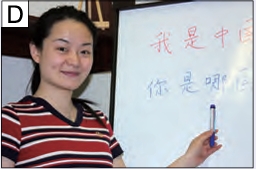





A:她(tā)是谁(shéi)?
B:她(tā)是我的(de)汉语(Hànyǔ)老师(lǎoshī),她(tā)叫(jiào)李(Lǐ)月(Yuè)。
A: Who is she?
B: She is my Chinese teacher. Her name is Li Yue.

| New Words | ||
|---|---|---|
| 1. 她 tā | pron. | she, her |
| 2. 谁 shéi | pron. | who, whom |
| 3. 的 de | part. | used after an attribute |
| 4. 汉语 Hànyǔ | Chinese (language) |
2 在图书馆 In the library 04 – 2

Nǐ shì nǎ guó rén?
A: 你是哪国人?
Wǒ shì Měiguó rén. Nǐ ne?
B: 我 是 美国 人。你呢?
Wǒ shì Zhōngguó rén.
A: 我 是 中国 人。
A: Which country are you from?
B: The United States. What about you?
A: I’m Chinese.
5. 哪 nǎ pron. which
6. 国 guó n. country, nation
7. 呢 ne part. used at the end of a question
3 看照片 Looking at the photo 04 – 3
Tā shì shéi?
A: 他是谁?
Tā shì wǒ tóngxué.
B: 他是我 同学。
Tā ne? Tā shì nǐ tóngxué ma?
A: 她呢?她是你 同学 吗?
Tā bú shì wǒ tóngxué, tā shì wǒ péngyou.
B: 她不是我 同学,她是我 朋友。

A: Who is he?
B: He is my classmate.
A: What about her? Is she your classmate?
B: No, she isn’t. She is my friend.
8. 他 tā pron. he, him
9. 同学 tóngxué n. classmate
10. 朋友 péngyou n. friend
注释 1 疑问代词 “谁”、“哪” The Interrogative Pronouns “谁” and “哪”
疑问代词 “谁” 在疑问句中用来询问人。例如:
The interrogative pronoun “谁” is used to ask about the name or identity of a person. For example:
| Subject | Verb | Object |
|---|---|---|
| 谁 | 是 | 李月? |
| 她 | 是 | 谁? |
| 他 | 是 | 谁? |
疑问代词 “哪” 用在疑问句中的结构形式为:哪+量词/名词+名词。例如:
When the interrogative pronoun “哪” is used in a question, the structure is “哪 + measure word/noun + noun”. For example:
- 哪本 (běn, a measure word for books) 书 (shū, book)?
- 哪个 (gè, a general measure word) 人?
- 你是哪国人?
2 结构助词 “的” The Structural Particle “的”
[名词/代词+的+名词] 表达一种所属关系。当 “的” 后的名词是亲属称谓或者指人的名词时,“的” 可以省略。例如:
The structure “noun/pronoun + 的 + noun” indicates possession. When the noun following “的” is a kinship or indicates a person, “的” can be omitted. For example:
- 李月是我的老师。
- 这 (zhè, this) 是我的书 (shū, book) 。
- 她不是我同学,她是我朋友。
3 疑问助词 “呢” (1) The Interrogative Particle “呢”(I)
疑问助词 “呢” 用在名词或代词后构成疑问句,用于询问上文提到的情况。常用的句式是:A……。B呢?例如:
The interrogative particle “呢” is used after a noun or pronoun, forming a question about the situation mentioned previously. The commonly used sentence pattern is “A……。B呢?” (A… What about B?). For example:
- 我不是老师,我是学生。你呢?
- 她叫李月。他呢?
- 我是美国人。你呢?

Comments